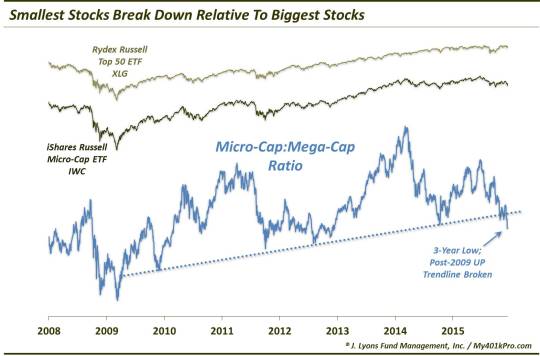Slump In Smallest Stocks Vs. Biggest Stocks Is Getting Worse

Micro-cap stocks have suffered a key breakdown relative to mega-cap stocks, suggesting a “risk-off” shift on the part of investors.
One of the themes in the stock market this year has been the under-performance of small-cap stocks – and conversely, the out-performance of large-caps. Today’s Chart Of The Day is a caricature of that theme as it involves a comparison between the very smallest stocks, micro-caps, and the very largest, mega-caps. Not surprisingly, the micro-caps have taken it on the chin this year relative to the mega-caps. In the past few days, however, the deterioration in micro-caps has accelerated, reaching a dubious milestone.
As measured by the ratio between the iShares Russell Micro-Cap ETF (IWC) and the Rydex Russell Top 50 ETF (XLG), micro-caps are at a 3-year low and have broken their uptrend that has been in place since 2009.

“So what?” you may say. “Something always has to be leading and something else has to be lagging” That is true. However, it is more bullish for the broad stock market when the smaller, more speculative issues are leading the way. When that is the case, it can be a sign of relative comfort and willingness to take on risk on the part of investors. Money will flow into stocks more readily under those circumstances.
However, when the micro-caps are lagging and the largest, seemingly most secure stocks are leading the way, it can be a sign of apprehension by investors to take risk. Money is less likely to find its way into the stock market under those “risk-off” circumstances.
Sure, we all know that these divergences can persist for some time. 2015 is a testament to that. Eventually, though, the small-cap weakness tends to leak into the broader market, including the large caps. The concern at this point is that the divergence has already persisted for some time. In fact, the micro-cap:mega-cap ratio topped back in March of 2014. So we are approaching 2 years of lagging small caps. At this point, the market segments that have thus far been able to avoid similar weakness are likely on borrowed time.
So, does that mean go out and sell all of your strong-performing large-caps also? Not at all. In fact, the relative weakness in small-caps is due, naturally, in part to the healthy action in the large-caps. We are strong proponents of relative strength, i.e., buy what is going up. Therefore, if you are going to own stocks right now, the large-cap space continues to be a place that warrants an over-weight allocation.
What about the strong seasonal pattern for small-caps? That is certainly a potential factor. As we noted in a few posts earlier this month, December has been exceedingly bullish for small-caps, particularly following an intra-month drawdown. Even if it wasn’t a seasonally positive time of year, a mean-reversion bounce by the small-caps in some fashion would not be too surprising.
However, we will go back to the topic of relative strength. What happens in the very short-term is highly unpredictable. However, concentrating on longer-term relative strength when allocating investments has worked best for us. Buying a stock in a long-term uptrend provides greater margin for error than trying to catch a falling knife. Even if you do not time your purchase ideally, you are swimming with the tide and are more likely to eventually see the position go your way.
The trend is your friend, in other words. And the trend continues to be strongly in the favor of mega-caps and against micro-caps. And while there may be bouts of mean-reversion in the small-caps’ favor, a durable shift their way is unlikely at this time. On the contrary, given the recent relative breakdown, an acceleration of the current trend away from micro-caps may even be forthcoming.
_________
Muhammad Ali photo from Daily Mirror.
More from Dana Lyons, JLFMI and My401kPro.
The commentary included in this blog is provided for informational purposes only. It does not constitute a recommendation to invest in any specific investment product or service. Proper due diligence should be performed before investing in any investment vehicle. There is a risk of loss involved in all investments.


